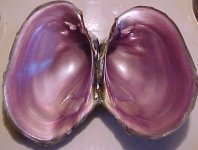In North America, it is estimated that 43% of the 300 species of freshwater mussels are in danger of extinction. Further, the current extinction rate (percent loss per decade) for freshwater mussels is 1.2% and is estimated to be 6.4% in the future. These rates fall within the range of estimates for tropical rainforest communities (1-8% loss per decade). Historically, the Midwest boasted the most diverse collection of mussels in the world. But today, the States of Minnesota, Wisconsin, Iowa, Missouri, Illinois, Indiana, and Ohio list more than half of their 78 known mussel species as endangered, threatened, or requiring special concern.
No other group of animals in North America is in such grave danger of extinction! Four mussel species that reside in the Upper Mississippi River basin receive
Federal protection under the Endangered Species Act of 1973. They are listed as endangered species and include the
winged mapleleaf,
Higgins' eye,
fat pocketbook and
scaleshell. The
sheepnose and
spectaclecase are candidate species.
Numerous other species are listed by the States of Minnesota, Wisconsin, Iowa, Illinois, and Missouri.





